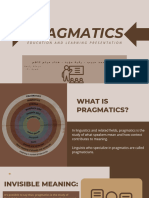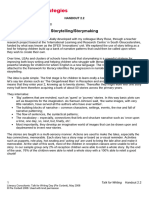INTRODUCTION TO ENGLISH LANGUAGE TEACHING
Course Code: ENG503
Semester: Spring 2025
Student Id: Bc240430346
ASSIGNMENT
QUESTION: -
“Words don’t always mean what they seem to mean’.
Explain this statement with reference to the study of semantics.
In your answer:
Define semantics in your own words
Give at least three clear and original examples to support your explanation.
ANSWER: -
SEMANTICS:
Semantics is the study of meaning in language. It helps us to understand how
words and sentences work together to convey meaning. When we talk or write, the words we
choose can have different meanings depending on the situation, culture and context.
Semantics is like a tool that helps us to figure out what people really mean when they
communicate. It is essential for effective communication building, relationships and avoiding
misunderstandings. By understanding semantics, we can become better communicator and
connect with others more effectively. Semantics in all around us shaping how we understand
each other and the world we live in.
EXAMPLE 1:
Let’s take the sentence “Can you open the window?”. On the surface, this question
seems to be about ability- it is asking if the person can practically open the window. But in
reality, the speaker is usually not asking about ability; they are making polite request for the
person to open window.
�This is an example of indirect speech acts in semantics. The literal meaning of words is different
from the intended meaning. The speaker is using a question about ability to make a request
without being direct. This shows how language can be used in subtle ways to convey meaning
beyond literal words.
In everyday conversation, we often use language like this to be polite, friendly or indirect.
Understanding these hidden meaning are important for effective communication and semantics
helps us grabs these complexities. By recognizing the difference between literal and intended
meanings, we can communicate more effectively and build strong relationships.
EXAMPLE2:
Let’s consider the phrase “He kicked the bucket.” If we take the words literally. It
means someone physically kicked the bucket. However the actual meaning is that the person
passed away. This phrase is an idiom, which is a common phenomenon in semantics.
Idioms are expressions that have meanings beyond the literal interpretation of
individual words. They often rely on cultural knowledge and context. Without understanding
the idiomatic meaning, people might get confused or misinterpret the message.
For example, if someone dose not know this idiom, they might imagine a person kicking a
bucket, which would be a completely different meaning. This highlights the importance of
semantics in understanding language hidden meanings. By learning about idioms and their
meanings we can improve our communication skills and avoid misunderstandings. Semantics
helps us navigate these complexities and communicate more effectively.
EXAMPLE 3:
Let’s look at the sentence “She’s cold.” On the surface, it might mean her body temperature
is low. But in different context, it could mean she’s emotionally distant or unfriendly. This shows
how words can have multiple meanings, which is known as polysemy in semantics.
When we say “She’s cold” the meanings depend on the situation and context. If someone says
this after meeting her, they might be talking about her body temperature. This ambiguity
highlights the importance of understanding semantics. Words can carry different meanings and
without context. It is easy to get the wrong message. Semantics help us to figure out what people
really mean by considering the context, tone and situation. By paying attention to these details,
we can communicate more effectively and avoid language misunderstandings. This is why it is
crucial to look beyond the literal meaning of words and consider the hidden meanings.
























































































